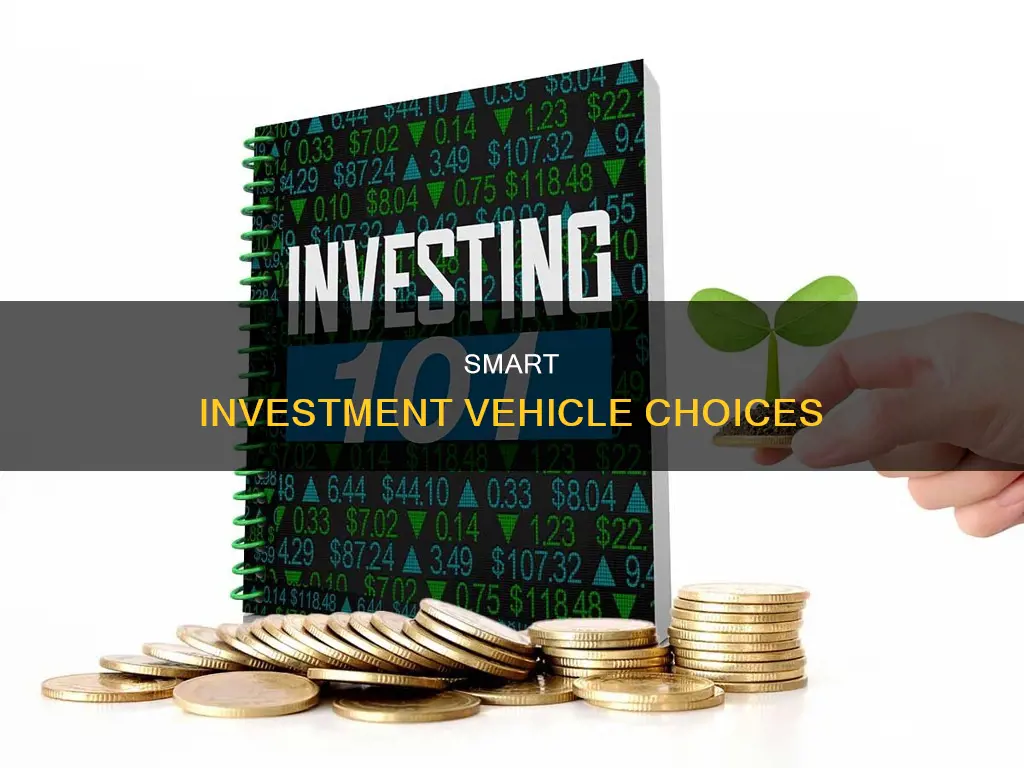
Choosing the right investment vehicle is an important step in achieving your financial goals. An investment vehicle is a method or product used by investors to grow their money and gain positive returns. There are various types of investment vehicles available, each with its own risks, rewards, and characteristics. So, how do you choose the right one?
Firstly, it's crucial to understand the different types of investment vehicles available. These can be broadly categorized into direct and indirect investments. Direct investments are specific asset holdings, such as stocks, bonds, or real estate, where the investor has complete control over the assets they purchase. On the other hand, indirect investments involve hiring professional portfolio managers to select and monitor the investments on your behalf.
Another classification of investment vehicles is public and private. Public investment vehicles are available to the general public and can be purchased through brokerage firms or traded on exchanges. Private investment vehicles, on the other hand, have restrictions and are typically only available to investors who meet certain income or net worth thresholds.
When choosing an investment vehicle, it's essential to consider factors such as expected returns, risk, liquidity, costs, and structure. Understanding your financial goals, risk tolerance, and investment horizon will help you select a vehicle that aligns with your needs. Additionally, seeking advice from a financial advisor can be beneficial in developing a suitable portfolio and investment strategy.
By carefully evaluating the characteristics and considerations of different investment vehicles, you can make informed decisions and choose the right investment vehicle to help you achieve your financial goals.
| Characteristics | Values |
|---|---|
| Expected Return | A realistic assumption of how much an investor could earn over an intermediate-to-longer-term period |
| Risk | How much an investor could lose if the investment falls short of the expected return; measured by volatility and maximum drawdown |
| Liquidity | How quickly and easily an investor can sell an investment for cash; more liquid investments have higher trading volumes |
| Cost | How much an investor pays to buy, sell, and hold an investment vehicle, including commissions, fees, and taxes |
| Structure | How the vehicle is organised and accessed by investors, including whether it is direct/indirect, public/private, its liquidity terms, costs, and whether it uses leverage |
| Pricing | How the market price is set, e.g. through trades on an exchange or by the sponsor based on the value of underlying holdings |
What You'll Learn

Taxation and investment vehicles
Taxation is an important consideration when choosing an investment vehicle. Ideally, we should all choose investment vehicles that will allow us to invest freely in any business we'd like without being taxed on the gains. However, this is not always possible, and taxation can have a significant impact on our compounded rates of return.
When you could simply buy and hold stocks, taxes would not be a concern. However, there are specific times when it's beneficial to sell to ensure your investments maximize the compounded annual growth rate of your capital. For example, you may need to sell to have money for the cost of living at retirement or earlier, or when your business investments cease to be wonderful.
There are certain investment vehicles that offer tax advantages. These include:
- Roth IRA: A Roth IRA is a type of investment retirement account (IRA) that allows you to invest money that has already been taxed. The special quality of the Roth is that the money you make on the money you put in is never taxed. You can invest a Roth in almost anything, and there is no tax when you take the money out after retirement. However, you can't take the money out until you turn 59 and a half.
- IRA: An IRA is another type of investment retirement account. With an IRA, you can put money in that you would have paid in taxes, allowing you to put away more money. However, when you start taking money out after you retire, you'll pay taxes on all of it. You'll also be forced to start taking it out and paying taxes on it at age 70 and a half.
- SEP-IRA: A SEP-IRA is similar to a regular IRA, but it is only available to small businesses. It allows you to put away up to 25% of your compensation, up to a maximum of $66,000, pre-tax.
- Cash Balance Plan: This type of plan is suitable for those who didn't put much away while building a business. It provides a defined benefit in the form of an annuity that the plan will buy when you retire. The annuity's size depends on how much you make every year and how little you put away toward retirement.
- Health Savings Account (HSA): An HSA is a vehicle that can be used to cover medical expenses. Contributions are tax-deductible, returns are not taxed until withdrawal, and you won't be taxed on withdrawals for qualified medical expenses. However, if you choose to spend these funds on non-medical expenses, you will be fined.
- Retirement Accounts: There are several types of tax-deferred retirement accounts, including 401(k)s, 403(b) plans, 457 plans, and traditional IRAs. With these accounts, you don't pay taxes on the funds until you withdraw the money during retirement. There are also retirement accounts like Roth IRAs where you pay taxes upfront, but any interest or capital gains earned grow tax-free.
When choosing an investment vehicle, it is important to consider the tax implications of each option. By understanding how each investment vehicle is taxed, you can make more informed decisions about where to allocate your assets to maximize tax efficiency.
Salary and Investment: A Correlation
You may want to see also

Low-risk vs high-risk vehicles
When it comes to investing, risk is an important factor to consider. Low-risk investments are generally considered to be those with a low probability of incurring losses, such as treasury securities, corporate bonds, money market funds, and fixed annuities. These types of investments usually offer modest returns and are suitable for investors who want to protect their capital while still benefiting from some growth. On the other hand, high-risk investments are those with a higher chance of loss or underperformance, such as stocks, options, and futures. These types of investments can offer higher returns but also come with a greater possibility of losing money.
Understanding Risk
It's important to note that risk is not a well-defined concept and there is no universal agreement on its meaning or measurement. However, a better way to think about risk is as the possibility of an asset experiencing a permanent loss in value or underperforming expectations. For example, if an investor buys an asset expecting a 10% return, the risk is the likelihood that the return will be below 10%.
Low-Risk Investments
Low-risk investments are those that have a low probability of incurring losses. While you may be less likely to see significant returns, you are also less likely to lose money. Examples of low-risk investments include:
- Treasury securities: These are backed by the full faith and credit of the government and are considered one of the safest investments.
- Corporate bonds: These are fixed-income securities issued by public companies with a very good credit rating.
- Money market funds: These invest in short-term, low-risk securities and are considered safe due to their liquidity and diversification.
- Fixed annuities: These are insurance contracts that provide a guaranteed income over a set period, often used for retirement planning.
High-Risk Investments
High-risk investments are those with a higher chance of loss or underperformance. These types of investments offer the potential for higher returns but also come with a greater possibility of losing money. Examples of high-risk investments include:
- Stocks: Buying individual stocks is riskier than bonds as it is difficult to diversify your portfolio and there is more responsibility to make gains.
- Options: These are a type of security that gives the holder the right to buy or sell an asset at a specified price on or before a specified date.
- Futures: A futures contract is an agreement to buy or sell a particular commodity or financial instrument at a predetermined price at a specified time in the future.
Choosing the Right Investment Vehicle
When choosing an investment vehicle, it's important to consider your financial goals, risk tolerance, time horizon, and current financial standing. Low-risk investments are generally suitable for those who want to protect their capital and are saving for short-term or medium-term goals. High-risk investments, on the other hand, may be more appropriate for those seeking higher returns and who are comfortable with a greater possibility of losing money. It's also important to note that diversification can help reduce the overall risk of a portfolio.
Why Invest in Entertainment?
You may want to see also

Direct vs indirect investments
When it comes to investing in real estate, there are two main categories: direct and indirect. Each comes with its own risks and benefits.
Direct Real Estate Investment
Direct real estate investment involves buying a stake in a specific property. This can be done through a debt investment, where you lend capital for the development or purchase of a property, or an equity investment, where you purchase an ownership stake in the property and share in the profits.
The benefits of direct investment include:
- Control over what you invest in: Investors can choose which assets to put their capital towards based on criteria such as location, property type, and deal structure.
- Tax relief and the ability to defer taxes: Direct investors may be able to write off maintenance and management expenses.
- Greater opportunity for capital appreciation: By investing in up-and-coming areas or renovations, direct investors can increase their ROI.
- Diversification opportunity: Real estate assets have historically risen with inflation, and there will always be a demand for them.
However, there are also some downsides to direct investment:
- Large upfront capital: Direct real estate investments often require significant upfront capital (typically at least $50,000), limiting the pool of potential investors.
- Less liquidity: Direct real estate investments often require large amounts of capital and involve a long, outdated selling/purchasing process with many intermediaries.
- Long investment horizon: It can take a long time for investors to recoup their initial investment and earn profits.
Indirect Real Estate Investment
Indirect real estate investment involves buying shares in a fund or stocks/shares in companies that invest in real estate, most commonly through Real Estate Investment Trusts (REITs) or Exchange-Traded Funds (ETFs). With indirect investment, you are typically investing in pooled assets with no control over how and where your money is invested.
The benefits of indirect investment include:
- Good for passive investors: This is a more "hands-off" model of investing, as indirect investments are managed by professionals.
- Less upfront capital required: Indirect investing requires less capital to get started (as little as under $100 in some cases).
- Ability to provide good diversification: Indirect real estate investments offer investors a chance to diversify their portfolio with assets other than stocks or bonds.
However, there are also some drawbacks to indirect investment:
- Heavily taxed: Indirect investments don't offer the same tax benefits as direct investments, and you must pay income tax on dividend returns and capital gains tax.
- No control over where the money goes: With indirect investment, you have no control over which specific properties you invest in.
- Less transparency: It can be difficult to find information about the condition of the assets, the property manager, and individual asset performance.
- High fees and lower returns: The fees associated with indirect real estate investing can be quite high (REITs typically have fees of 15%).
The choice between direct and indirect real estate investment depends on factors such as individual preference, available capital, risk tolerance, and how involved you want to be in the investment process. It's important to carefully assess your own capabilities and seek advice from professionals before making any investment decisions.
BlackRock: Investors' Choice
You may want to see also

Public vs private investment vehicles
When choosing an investment vehicle, it's important to understand the differences between public and private investment vehicles.
Public Investment Vehicles
Public investment vehicles are available for purchase by the general public. Most public investment vehicles are purchased through a brokerage firm that acts as a middleman to facilitate the trade. Some public investment vehicles, such as exchange-traded funds (ETFs) and closed-end funds, trade on an exchange that matches buyers with sellers. Other public investment vehicles, such as open mutual funds, are bought directly from the sponsor, although a brokerage firm may assist with the purchase.
Private Investment Vehicles
Private investment vehicles, on the other hand, are not available to the general public. Investors in private investment vehicles often must meet certain income or net worth thresholds to participate. In the US, there are different levels of qualification to invest in a private investment vehicle, such as being an accredited investor or a qualified purchaser. Examples of private investment vehicles include hedge funds, private real estate investment trusts, and venture capital limited partnerships. Many private investment vehicles are considered alternative investments because they invest outside of traditional public stock and debt markets.
Private investment funds are classified as such according to exemptions outlined in the Investment Company Act of 1940. Hedge funds and private equity funds are two common types of private investment funds that do not solicit public investment. Private investment funds have much lower regulatory and legal requirements than publicly traded funds, giving them more freedom in reporting, redemptions, and investment strategies.
Direct vs. Indirect Investments
It's also worth noting that both public and private investment vehicles can be further categorized into direct and indirect investments. Direct investments are specific asset class holdings or securities that generate an investment return, such as stocks, bonds, or rental real estate. Indirect investments are investment vehicles that hold direct investments selected by professional portfolio managers, who charge a management fee for this service.
Choosing the Right Investment Vehicle
When deciding between public and private investment vehicles, it's important to consider your financial goals, risk tolerance, and investment horizon. Private investment vehicles may offer higher potential returns but often come with higher costs and less liquidity. Public investment vehicles, on the other hand, provide easier access to a wider range of investment opportunities and are typically more liquid. It's recommended that most individual investors focus on public pooled indirect investment vehicles, such as index mutual funds or ETFs, as they are the most cost-effective way to gain diversified exposure to stocks, bonds, and real estate.
Bosnian Investment: Unlocking the Mystery
You may want to see also

Pooled investment vehicles
There are several types of pooled investment vehicles, including:
- Mutual funds: Actively or passively managed funds that can include stocks, mutual funds, bonds or other investments.
- Exchange-Traded Funds (ETFs): Combine the characteristics of a mutual fund and a stock. ETFs hold a collection of investments, including stocks, bonds, real estate and commodities, and trade throughout the day on an exchange.
- Hedge funds: Pooled investment vehicles that are run by a money manager or registered investment advisor. Hedge funds can offer diversification as they can pursue investment strategies that may not be an option with mutual funds or ETFs.
- Closed-end funds: Work opposite to open-end funds, with a limited number of shares available to investors. These funds are often associated with an initial public offering (IPO).
- Real Estate Investment Trusts (REITs): A way for investors to own real estate without actually owning property. REITs can also offer income in the form of dividends and a hedge against stock market volatility.
- Unit Investment Trusts (UITs): UITs buy stocks, bonds and other securities and then offer them to investors as redeemable units. UITs have an expiration date, after which they are dissolved and assets are distributed among investors.
- Pension funds: These are a bit different as the beneficiary usually doesn't get to choose how the pooled funds are invested. Instead, they are promised a certain retirement benefit and contribute to the pension fund for a number of years.
GME: The People's Investment
You may want to see also
Frequently asked questions
An investment vehicle is a product or instrument used by investors to gain positive returns. It is the method by which you invest your assets and control your money.
Investment vehicles include Individual Retirement Accounts (IRAs), 401(k)s, Roth IRAs, bonds, mutual funds, exchange-traded funds (ETFs), and more.
Investment vehicles can be categorized into two types: direct and indirect investments. Direct investments are specific asset class holdings or securities that generate a return, such as stocks, bonds, or rental real estate. Indirect investments are investment vehicles that hold direct investments selected by professional portfolio managers, such as mutual funds and ETFs.
When choosing an investment vehicle, consider factors such as expected return, risk, liquidity, cost, and structure. Understand the risks and rewards of each type of vehicle and ensure it aligns with your financial goals, risk tolerance, and current financial standing.
Investment vehicles provide a way to house and manage your money, offering control, tax advantages, and the potential for positive returns. They allow you to invest in a diverse range of assets and can help minimize risk through diversification.







